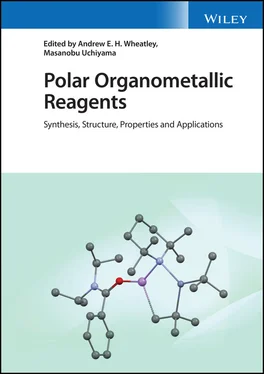Polar Organometallic Reagents
Здесь есть возможность читать онлайн «Polar Organometallic Reagents» — ознакомительный отрывок электронной книги совершенно бесплатно, а после прочтения отрывка купить полную версию. В некоторых случаях можно слушать аудио, скачать через торрент в формате fb2 и присутствует краткое содержание. Жанр: unrecognised, на английском языке. Описание произведения, (предисловие) а так же отзывы посетителей доступны на портале библиотеки ЛибКат.
- Название:Polar Organometallic Reagents
- Автор:
- Жанр:
- Год:неизвестен
- ISBN:нет данных
- Рейтинг книги:5 / 5. Голосов: 1
-
Избранное:Добавить в избранное
- Отзывы:
-
Ваша оценка:
- 100
- 1
- 2
- 3
- 4
- 5
Polar Organometallic Reagents: краткое содержание, описание и аннотация
Предлагаем к чтению аннотацию, описание, краткое содержание или предисловие (зависит от того, что написал сам автор книги «Polar Organometallic Reagents»). Если вы не нашли необходимую информацию о книге — напишите в комментариях, мы постараемся отыскать её.
Polar Organometallic Reagents
Polar Organometallic Reagents
Polar Organometallic Reagents — читать онлайн ознакомительный отрывок
Ниже представлен текст книги, разбитый по страницам. Система сохранения места последней прочитанной страницы, позволяет с удобством читать онлайн бесплатно книгу «Polar Organometallic Reagents», без необходимости каждый раз заново искать на чём Вы остановились. Поставьте закладку, и сможете в любой момент перейти на страницу, на которой закончили чтение.
Интервал:
Закладка:
Registered Office(s) John Wiley & Sons, Inc., 111 River Street, Hoboken, NJ 07030, USA John Wiley & Sons Ltd, The Atrium, Southern Gate, Chichester, West Sussex, PO19 8SQ, UK
Editorial Office The Atrium, Southern Gate, Chichester, West Sussex, PO19 8SQ, UK
For details of our global editorial offices, customer services, and more information about Wiley products visit us at www.wiley.com.
Wiley also publishes its books in a variety of electronic formats and by print‐on‐demand. Some content that appears in standard print versions of this book may not be available in other formats.
Limit of Liability/Disclaimer of Warranty In view of ongoing research, equipment modifications, changes in governmental regulations, and the constant flow of information relating to the use of experimental reagents, equipment, and devices, the reader is urged to review and evaluate the information provided in the package insert or instructions for each chemical, piece of equipment, reagent, or device for, among other things, any changes in the instructions or indication of usage and for added warnings and precautions. While the publisher and authors have used their best efforts in preparing this work, they make no representations or warranties with respect to the accuracy or completeness of the contents of this work and specifically disclaim all warranties, including without limitation any implied warranties of merchantability or fitness for a particular purpose. No warranty may be created or extended by sales representatives, written sales materials or promotional statements for this work. The fact that an organization, website, or product is referred to in this work as a citation and/or potential source of further information does not mean that the publisher and authors endorse the information or services the organization, website, or product may provide or recommendations it may make. This work is sold with the understanding that the publisher is not engaged in rendering professional services. The advice and strategies contained herein may not be suitable for your situation. You should consult with a specialist where appropriate. Further, readers should be aware that websites listed in this work may have changed or disappeared between when this work was written and when it is read. Neither the publisher nor authors shall be liable for any loss of profit or any other commercial damages, including but not limited to special, incidental, consequential, or other damages.
Library of Congress Cataloging‐in‐Publication Data
Names: Wheatley, Andrew E. H, editor. | Uchiyama, Masanobu, editor.
Title: Polar organometallic reagents : synthesis, structure, properties and applications / edited by Andrew E. H. Wheatley, University of Cambridge, Cambridge, UK; Masanobu Uchiyama, The University of Tokyo, Tokyo, JP.
Description: First edition. | Hoboken, NJ : Wiley, 2022. | Includes bibliographical references and index.
Identifiers: LCCN 2021037022 (print) | LCCN 2021037023 (ebook) | ISBN 9781119448822 (hardback) | ISBN 9781119448860 (adobe pdf) | ISBN 9781119448846 (epub)
Subjects: LCSH: Organometallic chemistry.
Classification: LCC QD411 .P63 2022 (print) | LCC QD411 (ebook) | DDC 547/.05–dc23
LC record available at https://lccn.loc.gov/2021037022LC ebook record available at https://lccn.loc.gov/2021037023
Cover Design: Wiley
Cover Image: © Piotr Zajc/Shutterstock, ANDREW E. H. WHEATLEY
Preface
Just as it has done for many years, organometallic and metalloorganic chemistry continues to play a vital role for synthetic chemists in the twenty‐first century. It offers some of the most effective ways of regiospecifically elaborating organic systems or of harnessing the potential of small molecules. Nevertheless, chemists constantly encounter challenges and target new systems which are not amenable to existing reagents. It is issues such as aggressive nucleophilicity or the implications of temperature instability or solvent sensitivity of many traditional organometallic bases, which have driven much of the research discussed in this volume. A major emergent theme covered is the potential of new, heterobimetallic systems. In particular, the problems of understanding just how reagents predicated on the action of two different metals operate. Synergy vs. cooperativity will be looked at in depth.
The new and often unique reactivities of these more complex reagents (or reagent mixtures) and their ability to achieve more effective chemical transformations under increasingly mild conditions are discussed. To do this, a broad view of organometallic chemistry is adopted, taking in organooxides, amides and the like as appropriate. Mostly, combinations of main group metals will be looked at but, in particular when considering environmental applications of bimetallic systems, coverage will extend to the d‐block. Divided into nine chapters, the volume broadly covers three main fields; structural chemistry in the solid state, understanding often catalytic processes by monitoring reaction pathways, and synthetic applications.
The first three chapters are dominated by the role of crystallography in understanding organometallic reagents and, in particular, heterobimetallics. Throughout the book, a range of crystal structures are reproduced. For ease, these omit minor disorder, lattice solvent and all but the most chemically relevant hydrogens. Chapter 1focuses on the work in the laboratory where a new generation of so‐called ate or synergic bases were originally developed. The advent of Kondo’s non‐nucleophilic zincates is considered and the implications for selective deprotonation are described. The major emphasis then switches to some of the most recent work in this area, where lithium cuprates have been studied and the idea of harnessing the oxidative flexibility of copper in coupling chemistry has been developed. If the first chapter shows anything it is that truly understanding the nature of many heterobimetallic reagents is vital to predicting or rationalizing their behaviour, and this frequently necessitates crystallographic determination. Chapter 2focuses on this through the prism of synergistic main group combinations. In particular, a more expansive view of the less strongly polarizing metal component of these systems is considered, enabling the demonstration of some mechanistic variation in formally synergistic systems. This introduces competition between concerted transformations by individually heterobimetallic reagents and stepwise conversions, where new reactivity is enabled in spite of individual steps proceeding through the action of much more traditional reagents that cooperate. Though Chapter 2tends towards the applications of these new systems, the theme is drawn out further in Chapter 3, where magnesiate chemistry begins to explore the seminal advances made by Mulvey and latterly O’Hara in what was originally termed ‘inverse crown ether’ chemistry but is now more broadly thought of in terms of a methodology for templating selective metalation. This has empowered chemists to achieve selectivities that contrast with those associated with established directing effects. Thereafter, looking elsewhere in group 2 allows an exploration of recent advances in calciate, strontiate, and bariate complexes.
Chapter 4is the first of two chapters dominated by a catalytic emphasis on our consideration of applied chemistry. It does this, though, through the lens of understanding chemical processes. It directs the reader towards the role of computation in understanding how heterobimetallic complexes that now take in d‐block as well as main group elements can work, and also the applications of these systems in environmentally relevant polymerization processes dependent on the activation of small molecules. As is pointed out, proving positive cooperative effects is easily done, though understanding the nature and origin of a cooperative mechanism remains difficult, with concerted or consecutive actions of different metals potentially competing, and then with variance between formal metal–metal bonding or metals tethered by bridging ligands. In all this it is important to bear in mind that limited direct observation of structures will typically be possible on catalytic species in operando . Catalysis remains the dominant theme in Chapter 5, but more through the prism of p‐block chemistry, and of group 13 in particular. Noting that the domain of catalysis has been dominated by d‐block metals, this chapter records that the beginning of the twenty‐first century has seen a shift towards main group element alternatives. This is the context then in which the remarkable reactivity of group 13 compounds have entered the catalytic arena. While tuning of their Lewis acidity and electrophilicity is possible by varying metal coordination number, it is the conversion of covalent complexes into cationic derivatives that will dominate. The chapter provides an overview of recent developments in the synthetic, characterization, computation and reactivity studies and applications in catalysis of cationic complexes. It will cover boron for completeness, but focus on aluminium and the higher group 13 elements.
Читать дальшеИнтервал:
Закладка:
Похожие книги на «Polar Organometallic Reagents»
Представляем Вашему вниманию похожие книги на «Polar Organometallic Reagents» списком для выбора. Мы отобрали схожую по названию и смыслу литературу в надежде предоставить читателям больше вариантов отыскать новые, интересные, ещё непрочитанные произведения.
Обсуждение, отзывы о книге «Polar Organometallic Reagents» и просто собственные мнения читателей. Оставьте ваши комментарии, напишите, что Вы думаете о произведении, его смысле или главных героях. Укажите что конкретно понравилось, а что нет, и почему Вы так считаете.












